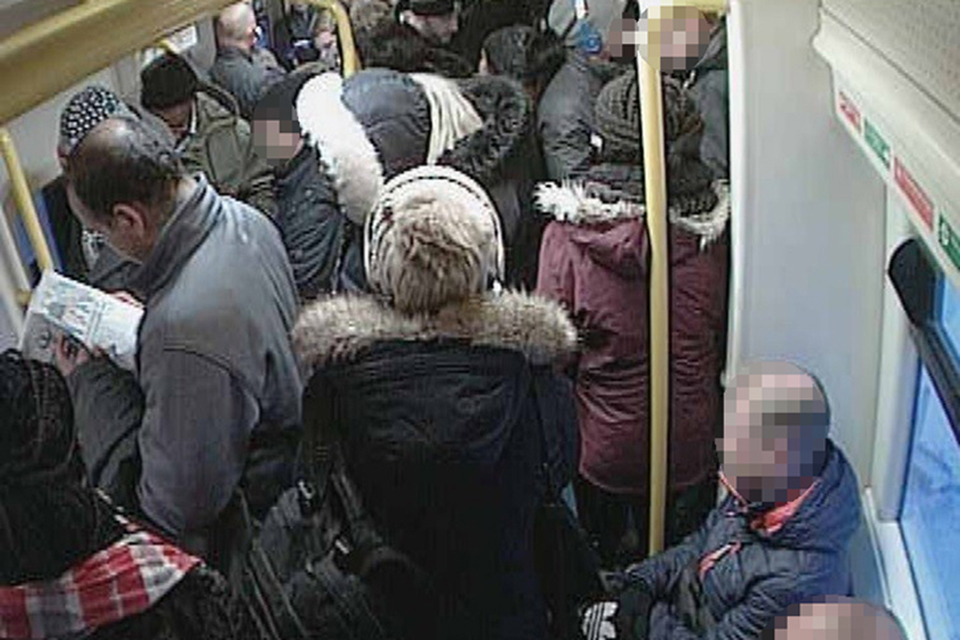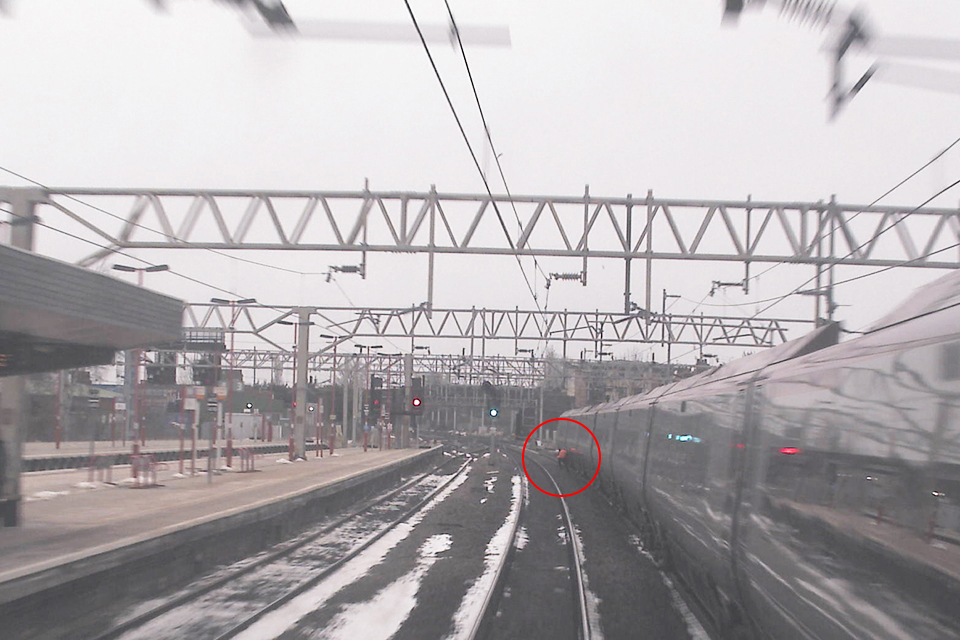Summary of learning - 4. The safe management of abnormal train-operating events which put passengers and crews at risk - v1. May 2020
Published 2 April 2020
1. Purpose of this summary
The purpose of this document is to provide a repository of some of the most important areas of learning identified in RAIB’s investigations to date, cross-referenced to relevant reports. It therefore provides a reference source for those looking to understand real-world railway safety issues and potential control measures.
When preparing this document, RAIB has selected those issues which:
- have recurred in different RAIB investigations
- have still to be fully addressed
- could be a factor in the cause of a fatal accident
RAIB is aware that many of the issues raised have already been the subject of actions by duty holders when responding to RAIB recommendations, or are in the process of being addressed. The inclusion of a topic in this document should not be taken to mean that no action has been taken in response to relevant recommendations. However, its inclusion indicates that RAIB is of the view that the issue still needs to be actively managed by duty holders.
The current status of each recommendation made by RAIB can be checked by reference to the Index of RAIB recommendations, and details of the actions taken are published by ORR.
It is not the purpose of this document to quantify the risk associated with each of the identified safety issues. Readers seeking to understand the overall risk of harm associated with various dangerous events should refer to RSSB’s Annual Safety Performance Report. This presents historical information on actual harm caused, and estimates of risk based on extensive modelling.
2. Overview
Minor technical faults on trains are a daily reality on the railways, but sometimes these minor events, if not identified and dealt with effectively, can quickly develop into a potential safety incident. If such an incident results in serious risk to passengers or train crew, and there is the potential for important safety learning, RAIB will investigate.
When trains stop between stations, passengers can understandably soon become worried or impatient. In some cases people may decide to make their own way out of the train and continue their journey on foot. In doing so they put themselves at risk and cause an escalation of the delay, as other trains have to be stopped and electric power may have to be turned off until the tracks are confirmed to be clear.
The conditions experienced by passengers can deteriorate rapidly on electric trains which lose their power supply, for whatever reason. Reduction of lighting, toilets which no longer function and loss of air conditioning can create an extremely unpleasant environment. In hot weather, the loss of air conditioning can result in a rapid rise in temperature in a sealed train, leading to passengers deciding that they need to escape from the train.
Dealing with such situations can be very challenging for train crew, as they may have technical tasks to perform as well as responding to the needs of the passengers. There can be particular problems on local and suburban trains which do not have toilet facilities, and may also be very crowded with standing passengers, making it difficult for train crew to pass through the carriages. Some trains may have over one thousand passengers on board.
On 9 August 2019, a drop in the National Grid’s supply frequency caused technical problems on trains and led to the stranding of 30 class 700 trains for up to four hours, causing disruption to journeys to and from north London. It is important that proper support is available for staff when trains are stranded, and that there are suitable, up-to-date and adequately rehearsed plans in existence for recovering the situation.
3. Important areas for safety learning
The main topics of concern to RAIB are described below.
3.1 Support for train drivers during incidents
Drivers only very rarely encounter incidents in which their trains fail and become stranded, so they may find that this lack of experience makes dealing with these events very challenging. They may be the only member of staff on the train. In this situation responsibility for fault-finding, liaison with signallers and control room staff and keeping passengers informed will all fall to one person. As at Kentish Town in 2011 (report 07/2012) and Peckham Rye in 2017 (report 16/2018), RAIB has found that sometimes the driver is poorly supported by their employer’s control room, and they can become overwhelmed by events and make poor decisions. It is challenging and difficult to keep a cool head when dealing with such pressures, especially as such events are rarely experienced. We have recommended improved support for drivers when dealing with out-of-course events such as signals passed at danger (SPADs) and train failures.
3.2 Management of operational interfaces
The UK’s railway is not vertically integrated, and different companies operate the signalling and the trains. There may be more than one train operator involved when multiple trains are stranded by bad weather or power failure. In circumstances in which train faults have occurred, as at Peckham Rye in 2017 (report 16/2018), RAIB has found poorly managed operational interfaces between different train operating companies, signallers and control offices.
3.3 Recognition of developing incidents
The time taken for train operators, through their control rooms, to recognise that a situation involving a stranded train is potentially dangerous and needs to be managed is sometimes too long. Expectation that a train will be able to move in a few moments more can lead to a decision to intervene being delayed until overtaken by events such as passengers self-evacuating. This was a finding of RAIB’s investigation into the self-detrainment of passengers at Lewisham in 2018 (report 01/2019).

Commuters in one of the trains that became trapped near Lewisham.
RAIB has found that there is a need for measures to help operating staff recognise that an incident involving a stranded train on a busy urban railway will rapidly become a ‘safety incident’, and that decisive action is needed to manage the situation, and that staff have the training and skills to be able to manage this situation before it gets worse.
3.4 Trains stranded remote from stations
If trains are stranded a long way from the nearest station, it can be difficult to look after the welfare of passengers. RAIB has identified a need for measures to ensure that stranded trains are routed to locations where passengers can be safely evacuated, whenever possible. An example of how this can be done is Emergency Special Working, which can enable trains to move when multiple signals cannot be cleared, and has recently been added to the Rule Book.
3.5 Management of stranded trains
As well as drivers (see above), signallers and operations controllers can also have little experience of stranding incidents, and be unprepared to deal with them when they happen. RAIB found this to be the case in the incidents at Peckham Rye in 2017 (report 16/2018) and Lewisham in 2018 (report 02/2019). There is a need for improved planning, and enhanced training, simulation or practical exercises, to enable operating staff to effectively manage incidents where one or more trains are stranded.

The control room of a train operating company.
3.6 Communications during incidents
A symptom of such unpreparedness is poor and ineffective communications between drivers, signallers and controllers during an abnormal event. At Bethnal Green in 2018 (safety digest 04/2018), RAIB found that poor communications resulted in a misunderstanding which led to a driver moving a train without the signaller’s permission. At Stafford in 2018 (safety digest 03/2018), confusion arising from poor communications resulted in a near miss between a train travelling at 85 mph and a train driver who was on the track examining his train. There must be clear safety-critical voice communications in such circumstances, which should follow from embedded practice within the industry. However, several investigations have found that communications are often not adequate to convey the right information and enable effective decisions to be made. At North Pole Junction in 2019 (safety digest 09/2019), the standard of communication was poor and messages were not passed correctly, leading to delays in decision making and finally to passengers evacuating themselves from a train in which conditions had become extremely hot and unpleasant.

The near miss at Stafford.
This emphasises the need for regular communications with passengers as a situation develops, to inform people about what has happened and advise them about safe behaviour and what is being done to resolve matters. Modern radio systems make it possible for there to be direct communication between operations controllers and the train, and this has recently been put into practice in incidents in Scotland.
3.7 Preparedness for winter conditions and extreme weather
The railway in general, and lines electrified on the conductor rail system in particular, are vulnerable to disruption by ice and snow. At Lewisham in 2018 (report 02/2019), this disruption initiated events which led to significant issues of passenger safety and welfare. RAIB’s report on this incident identified a need for Network Rail to review the adequacy of existing measures for combating severe weather, such as increasing the deployment of conductor rail heating in urban areas.
Recent events have shown the vulnerability of overhead line systems to damage from a variety of sources, including objects from outside the railway, bird strikes and damaged equipment on trains. When this happens, recovery can be slow and trains will often be stranded without power. Although this is not solely a weather issue, high winds can affect some of the older power supply systems.
4. Rail industry’s strategic safety groups
Network Rail’s National Operations Programme is intended to overhaul the structure of operations management in the company, including its ability to respond promptly and effectively to incidents of disruption on the network.
5. Relevant RAIB publications
- Safety incident between Dock Junction and Kentish Town (report 07/2012)
- Near miss with a train driver at Stafford (safety digest 03/2018)
- Operational incident following a signal passed at danger, Bethnal Green (safety digest 04/2018)
- Detrainment of passengers onto electrically live track near Peckham Rye station (report 16/2018)
- Self-detrainment of passengers onto live operational track at Lewisham (report 02/2019)
- Passengers self-evacuating at North Pole Junction (safety digest 09/2019)

